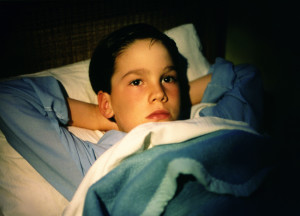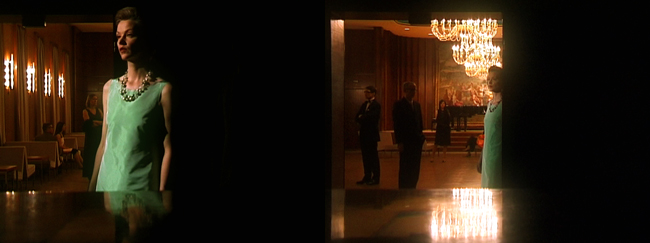Now Available – Digital copies of Seven Works by Matthias Müller
Posted November 28th, 2017 in Announcements, New Acquisitions, News / Events
Canyon Cinema is pleased to announce that Matthias Müller is making available the following seven of his films in digital formats, in addition to the 16mm and 35mm prints in distribution:

Alpsee | 1994 | 15 minutes | COLOR | SOUND
Rental Format(s): 16mm film, 24 fps / Digital File
“Despite the seemingly innocuous gestures of household life, a dark, unmanageable world seems to want to erupt from it. At one point it literally does: in a stunning image, the milk the mother pours for her son overflows the glass onto the table, the floor, and eventually down the hall in an endless stream. This uncontrolled secretion, pure white, is disturbingly connected to the enigmatic maternal body. The sparse decor of the home, the primary color scheme, and high key lighting all emphasize the preternatural clarity of the image in ALPSEE. As in allegory, the sharp definition of the image belies its opaque, brooding signification. The pristine look of this film thus gives rise to its confusing, nightmarish quality, borne out of its name: the German word for nightmare is Alptraum.”
– Alice A. Kuzniar: The Queer German Cinema. Stanford, California, 2000

Mirror | 2003 | 8.16 minutes | COLOR | OPT
Rental Format(s): 35mm film / Digital File
co-directed and co-produced by Christoph Girardet
“The elegant protagonists flit enigmatically in and out of view, but the real star of the show is the light. Sumptuous, formally composed cinematic images, all surface and suggestion, convey the split in a couple’s connection through patterns of light that isolate and separate them. It’s a haunting piece.”
– Tina Jackson, The Guardian, London, 2004
Home Stories | 1991 | 6 minutes | COLOR | SOUND
Rental Format(s): 16mm film, 24 fps / Digital File
“Framed by a tense, complex soundtrack of found sounds and musical snippets from those same postwar melodramas, the imagetrack gradually builds up a claustrophobic sensation of paranoid anxiety in these women’s actions. The film incorporates clips already pregnant with quiet hysteria, but their decontextualiztion and carefully edited repetition extenuate their excess as moments of cinema. Home Stories rises to a climax of collective hysteria as the women hurry down hallways and anxiously shut doors behind them. Ominously, the source of their apparent terror remains nowhere to be seen. While Home Stories undoubtedly elaborates a shrewd ideological critique of gender construction and the home, it moreover draws much poetic and affective power from the cinematic excess embedded in these narratively insignificant moments from popular cinema.”
– Roger Hallas: Reframing Bodies – AIDS, Bearing Witness, and the Queer Moving Image. Durham/NC 2009
Penasao Globo | 1997 | 15 minutes | COLOR | SOUND
Rental Format(s): 16mm film, 24 fps / Digital File
“The film presents one visually dominant theme, the constant superimpositions, or double exposure effect, of what is being shown. The man seems to be accompanying himself as a ghost, the world escapes him continually, things are no longer fixed in their proper places; nothing remains still. The shots of the man in the hotel are taken from two slightly different positions but from the same distance, the lighting is intensified and is slightly distorted in time and space. (…) There have been too many attempts to transform poetry into film in the history of cinema. PENSAO GLOBO, however, represents something else. Müller does not limit himself to an attempt to translate an existing verbal structure into images. His success lies in being able to repeat in cinema the same structural act that is the basis of poetry.”
– Peter Tscherkassky, “Ein Dichter der Bilder”, Pesaro, 2000
Sleepy Haven | 1993 | 15 minutes | COLOR | SOUND
Rental Format(s): 16mm film, 24 fps / Digital File
“Blue is the color of the sea, but it is also the color of Romanticism, whose phantoms of desire haunt this reverie. Images flow by to the sound of a scratched record, lappig waves, and the monotonous crescendo and decrescendo of a repeated string of music that matches the fade-ins and fade-outs. Ships heave at the dock, anchors drop into water, dripping ropes tug at chains, and naked sailors sleep in their berths, tossing and turning to the rhythm of their ships. The montage intimates that, as in Jean Genet’s Un Chant d’Amour, each man is (in) the dream of the other. (…) As in The Memo Book, the medium itself imparts an erotic palpability: the image pulses in flashes and phosphorescent blues and is drowned in bubbles. Light and shadows move in syncopation across the frame like waves. The repeated cadence of the fade to black is lulling, as if the drowsy eyelid were closing and reopening. The entire films seems to want to induce a trancelike state. Enhanced by Dirk Schaefer’s lulling music, the appearance and disappearance of the image mimics the rhythms of the body – a palm opening, nocturnal tossings, the heartbeat, and breath.”
– Alice A. Kuzniar: The Queer German Cinema. Stanford/California, 2000
Vacancy (Matthias Muller | 1998 | 15 minutes | COLOR | SOUND
Rental Format(s): 16mm film, 24 fps / Digital File
“In its relentless looking back on the past and its inability to envision a future, VACANCY is the quintessential millennial film. A shot of particularly long duration features more than a dozen labourers washing a concrete wall which supports a highway overpass. This image is punctuated by a quick archival shot of the wall in its original pristine state. Misguided notions of progress have given way to pointless rovings and meaningless activities. The city is empty, its inhabitants gone, and yet we continue to prop up its corpse.”
– Scott McLeod, “The Shape of a particular Death: Matthias Müller’s Vacancy”, in: LUX – A Decade of Artists’ Film and Video, Toronto
Scattering Stars (Matthias Muller) | 1994 | 2 minutes | B&W | SOUND
Rental Format(s): 16mm film, 24 fps / Digital File
“Against a pitch-black night-time sky, splendid fireworks explode. From a different darkness, gleaming male body parts light up. Meticulous cutting and solarisation make the fireworks seem to emerge from the very centre of the bodies.”
– International Film Festival Rotterdam, 1995
See Mathias Müller’s filmmaker page, in the Canyon Cinema catalog.






